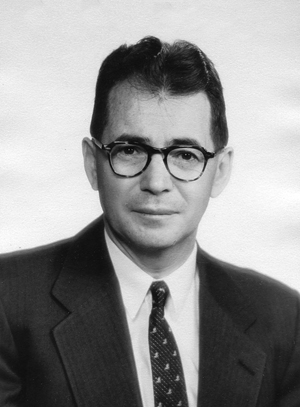Legendary teacher, author, and administrator Himie Voxman died on November 22, 2011, in Iowa City, Iowa. He began his musical career at 13 as a clarinet student with William Gower, Sr. and Gustave Longenus. He earned a B.S. with high distinction in chemical engineering and an M.A. in the psychology of music at the University of Iowa. During his graduate study he taught woodwinds in nearby public schools and joined the University of Iowa faculty in 1939. He served as director of the school of music from 1954 to 1980 and published about 300 editions, articles, and compilations for wind instruments. The University of Iowa renamed its music building for Voxman in 1995. The Instrumentalist published several of his articles over the years. We reprint some of the best excerpts here as a tribute to his remarkable contributions to music education over the last century.
 Starting in Music – June 1993
Starting in Music – June 1993 The young lady music supervisor in Centerville was a go-getter who each school year asked our grammar school teachers for a list of students who might be interested in beginning a musical instrument. In most instances the teachers chose students on the basis of academic rather than musical ability. The lists were given to Mr. Gower, who then contacted parents. My mother agreed to buy a used Albert-system clarinet for $35 and have me begin lessons.
Later, I played clarinet for the silent movies, but it was just for fun, and I didn’t get paid. If I had time after school, I went in the back door of the theatre, sat down, and played. We played for some wonderful early movies, but there was never time to look and watch the screen. Each week during these summers I travelled hundreds of miles playing concerts with Gower’s band.
At the end of my junior year in high school, Gower recommended me to the Scots Kiltie Band, which needed a temporary clarinet player for its performances at the Missouri State Fair. I stayed with the band all summer, earning $60 a week. This was a pile of money in days when you could get a room for $1.25 a night and meals for 25 cents. The director asked me to continue on in the fall, but I wanted to finish my senior year of high school. Despite assurances that I could rejoin the band the next summer, the director gave the work he had to people with families to support. It was the late 1920s and talkies had come, making movie house pit orchestras unnecessary. That ended my life as a professional bandsman, but who knows what I would have become if I stayed on that fall.

Woodwind Repertoire – June 1993
My teacher, William Gower, once took me to Jenkins Music Store in Kansas City, where I found Hohmann’s Method for Violin. Its excellent violin duets led me to explore the string literature for additional material. Much of it was far superior to what was available for clarinet. When I compiled my various ensemble collections, I was anxious to acquaint students with the names of the famous composers as well as arrangements of their works. For example, my first book of trios for three Bb clarinets has pieces by Mozart, Handel, Billings, Hummel, and Schubert, among others. I have found that such music appeals to young students, and I hope that teachers use the music as an opportunity to say a few words about the composers.
Gower wrote out the first 12 lessons for his students and then moved on to the standard clarinet literature. After I began teaching in Iowa in the mid-1930s, I suggested that we add enough to his lesson materials to provide for a school year. Eventually, we wrote an elementary method that Jenkins bought; the book had a remarkable first-year sale of 6,000 copies.
When we suggested a follow-up book to Jenkins, they did not express interest. Rubank had published the arrangement I had made of part of Weber’s Second Clarinet Concerto. When I showed them the Advanced Method we had prepared, they immediately agreed to publish it, and although Jenkins threatened to sue, Rubank was not intimidated. So began my relations with that firm. They later asked for other methods, solo and ensemble collections. (The Voxman Method, An Interview with Himie Voxman by Shirley Strohm Mullins, June 1993)
Tempo – December 1997
A few years ago I was criticized by an angry band director at a district woodwind contest after I had awarded two of his best woodwind contestants a less than top rating. His bassoon student had chosen the Allegro first movement of Mozart’s Bassoon Concerto in Bb and performed it quite well but at an andante pace, about q = 66. He had a nice tone and played accurately, but he had not really played Mozart’s Allegro. He had merely done an excellent
job of reading the notes.
The director listened to me impatiently and finally burst forth with “Tempo isn’t everything!” He cited an eminent cornetist and conductor at a festival who conducted a piece written in alle breve and beat it in four. I hastened to agree with him that tempo isn’t everything, and I could have added that tone isn’t everything, and technique isn’t everything. The ultimate equation is that nothing is everything, but I believe that everything is something.” (Tempo Isn’t Everything by Himie Voxman, December 1997)
Making Time for Music – August 1960
A much more serious and insidious attack has been the usurpation of curricular time that was acquired only after decades of intensive effort. Without great ado or debate, the high school (and in many instances the junior high) curriculum has been “enriched” partly at the expense of music. Many teachers must feel that the musical carcass has been attacked by long starving birds of prey. The implication of this unilateral action by administrators and school boards obviously implies that when the chips are down the music program cannot stand up with the other hard-core content areas such as science, mathematics, foreign language, and literature.
Evolving Band Repertoire – Aug. 1960
The most casual historian of the musical scene of the past 30 years is aware of the currently larger quantity of respectable literature in the pedagogical and concert fields. True, there are notable gaps. The most serious, perhaps, is in the band field. There are few numbers yet available that seem destined for more than a transient existence. The bulk of viable repertoire is still transcriptions. It is heartening to find an increasing interest on the part of the American composer in this dilemma. (The Music Men Live By by Himie Voxman, August 1960, the full article is online)





